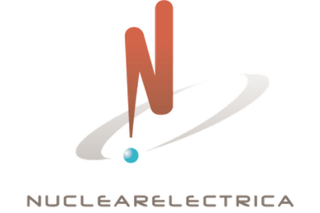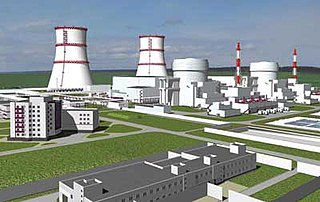
The CANDU is a Canadian pressurized heavy-water reactor design used to generate electric power. The acronym refers to its deuterium oxide moderator and its use of uranium fuel. CANDU reactors were first developed in the late 1950s and 1960s by a partnership between Atomic Energy of Canada Limited (AECL), the Hydro-Electric Power Commission of Ontario, Canadian General Electric, and other companies.
Atomic Energy of Canada Limited (AECL) is a Canadian federal Crown corporation and Canada's largest nuclear science and technology laboratory. AECL developed the CANDU reactor technology starting in the 1950s, and in October 2011 licensed this technology to Candu Energy.

The Jaslovské Bohunice Nuclear Power Plant (NPP) is a complex of nuclear reactors situated 2.5 km from the village of Jaslovské Bohunice in the Trnava District in western Slovakia.

The EPR is a third generation pressurised water reactor design. It has been designed and developed mainly by Framatome and Électricité de France (EDF) in France, and by Siemens in Germany. In Europe this reactor design was called European Pressurised Reactor, and the internationalised name was Evolutionary Power Reactor, but is now simply named EPR.
The Advanced CANDU reactor (ACR), or ACR-1000, was a proposed Generation III+ nuclear reactor design, developed by Atomic Energy of Canada Limited (AECL). It combined features of the existing CANDU pressurised heavy water reactors (PHWR) with features of light-water cooled pressurized water reactors (PWR). From CANDU, it took the heavy water moderator, which gave the design an improved neutron economy that allowed it to burn a variety of fuels. It replaced the heavy water cooling loop with one containing conventional light water, reducing costs. The name refers to its design power in the 1,000 MWe class, with the baseline around 1,200 MWe.
Nuclear Power Demonstration was the first Canadian nuclear power reactor, and the prototype for the CANDU reactor design. Built by Canadian General Electric, in partnership with Atomic Energy of Canada Limited (AECL) and the Hydro Electric Power Commission of Ontario it consisted of a single 22 MWe pressurized heavy water reactor (PHWR) unit located in Rolphton, Ontario, not far from AECL's Chalk River Laboratories. NPD was owned by AECL and operated by Ontario Hydro.
Nuclear power in Canada is provided by 19 commercial reactors with a net capacity of 13.5 gigawatt (GW), producing a total of 95.6 terawatt-hours (TWh) of electricity, which accounted for 16.6% of the country's total electric energy generation in 2015. All but one of these reactors are located in Ontario, where they produced 61% of the province's electricity in 2019. Seven smaller reactors are used for research and to produce radiopharmaceuticals for use in nuclear medicine.

The Nuclear Power Plant in Cernavodă is the only nuclear power plant in Romania. It produces around 20% of the country's electricity. It uses CANDU reactor technology from AECL, using heavy water produced at Drobeta-Turnu Severin as its neutron moderator and as its coolant agent. The Danube water is not used for cooling of the active zone.

Electrabel SA is a Belgian energy corporation. It is a subsidiary of French multinational utility company Engie S.A..

China is one of the world's largest producers of nuclear power. The country ranks third in the world both in total nuclear power capacity installed and electricity generated, accounting for around one tenth of global nuclear power generated. As of February 2023, China has 55 plants with 57GW in operation, 22 under construction with 24 GW and more than 70 planned with 88GW. About 5% of electricity in the country is due to nuclear energy. These plants generated 417 TWh of electricity in 2022 This is versus the September 2022 numbers of 53 nuclear reactors, with a total capacity of 55.6 gigawatt (GW). In 2019, nuclear power had contributed 4.9% of the total Chinese electricity production, with 348.1 TWh.

Engie SA is a French multinational utility company, with its headquarters in La Défense, Courbevoie, which operates in the fields of electricity generation and distribution, natural gas, nuclear, renewable energy and petroleum. It is active in both upstream and downstream activities.

SN "Nuclearelectrica" S.A. (SNN) is a partially state-owned Romanian nuclear energy company incorporated in 1998 by the reorganization of RENEL. The company is under the authority of the Ministry of Energy, and the state has 82.49% of the shares and other shareholders - 17.50% after listing the company at the stock exchange in 2013.
Romania is the 38th largest energy consumer in the world and the largest in South Eastern Europe as well as an important producer of natural gas, oil and coal in Europe.

The Kaliningrad Nuclear Power Plant (also referred as Baltic Nuclear Power Plant (NPP) or Baltiiskaya NPP, Russian: Калининградская атомная электростанция; Калининградская АЭС [] or Балтийская АЭС []) is a nuclear power plant under construction 13 kilometres (8.1 mi) south-east of Neman, in Kaliningrad Oblast, Russia. It is seen as a counter-project to the (later scrapped) plan to build the Visaginas nuclear power plant in Lithuania and is considered not only as an energy, but also as a geopolitical project. Originally intending to commission the reactors in 2016 and 2018, construction was temporarily stopped in June 2013 for the project to be redesigned for lower power output after neighbouring countries showed no interest in importing its electricity. However, the downgrade was later discarded. No export partners materialised as of 2021 and the project remains in stand-by.
The Doiceşti Power Station was a large thermal power plant located in Doicești, with seven generation groups, six of twenty MW each and two of 200 MW resulting in a total electricity generation capacity of 520 MW. It used Lignite as main fuel supplemented by Natural gas.
Slovakia has five operational nuclear reactors, with a combined net power capacity of 2,308 MWe, with a sixth coming on line shortly.
The following outline is provided as an overview of and topical guide to nuclear power:

The IPHWR-700 is an Indian pressurized heavy-water reactor designed by the NPCIL. It is a Generation III reactor developed from earlier CANDU based 220 MW and 540 MW designs. It can generate 700 MW of electricity. Currently there is one unit operational, 7 units under construction and 8 more units planned, at a cost of ₹1.05 lakh crore (US$13 billion).
In accordance with EU directives and climate control ambitions, additional effort and money was put into improving renewable energy sources. The target of 24% renewable energy was reached in 2020.










